Spain is the second largest country in Western Europe after France in terms of land size, though is one of the least densely populated countries in Western Europe. Spain encompasses most of the Iberian Peninsula — a block of land on the west side of the Mediterranean Sea that is connected on the north to mainland France. The southernmost part of mainland Spain is literally only a Continue reading
Monthly Archives: January 2009
Chores and Day 1 of Passage to Mallorca, Spain
Yesterday was yet another chore day. Sometimes we feel like the boat chores are cumbersome and we wish we were traveling like a regular tourist, where every day is a sightseeing day and you never have to take time away from sightseeing to clean and do maintenance. But our trip to Paris was a reminder of why we chose to travel by boat. Going to and from Paris we schlepped our bag on several trains, busses and subways, and up and down at least a million stairs. Our bag was small and light, but it was still a hassle, especially on the tightly packed subways. How much of a hassle would it be with the big, heavy bags we would have for long term traveling? And it is so nice to have your own bed and your own bathroom, never having to wonder if your hotel is going to be up to your preferred standards. Another bonus of traveling via private boat is not having to pack up your stuff every time you move on to the next place. And, we have figured out that no matter how you travel, whether plane, train, or boat, traveling for many hours wears you out exactly the same. We prefer the privacy and comfort of our own home as we travel, instead of in an uncomfortable, public medium.
Eric was busy all day. He Continue reading
Arc de Triumph, Angelina’s, and Electricity
We were catching the train back to Toulon in the early afternoon, so we didn’t have much time for sightseeing today. This morning we raced off to the Arc de Triumph, located in the center of the world’s largest traffic circle, Charles de Galle. The Parisians seem to have a weird fetish for putting important monuments in traffic circles. 12 streets radiate out from the Charles de Galle traffic circle, going to all sections of the city. There is an accident every 18 minutes in the circle, so some auto insurance companies have a clause that this circle isn’t covered. The Arc was commissioned in 1806 by Napoleon to commemorate his victories, but when he started losing battles, the work stopped. It was eventually finished in 1836.
We got off the subway and went over to the intersection. Yep, it is an arch, much the same as the ones we saw in Rome. And it’s tall.
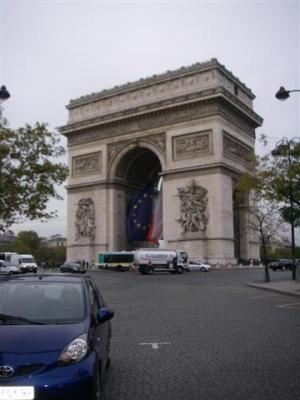
We wandered from street to street on the outside of the circle looking for the tunnel that goes under the street into the circle. We eventually found it on Champs-Elysees. Like the other arcs we have seen, it is Continue reading
The Louvre Museum and Dinner with Louis
Continued from yesterday”¦The next stop was a quick tour of the Apollo Gallery next door to the Italian Gallery. This is ridiculously opulent room, with carved and gilded walls and ceilings. On the walls are portraits of various important people and on the ceilings are more statues. There is so much gilding that the walls and ceiling look to be solid gold from a distance.
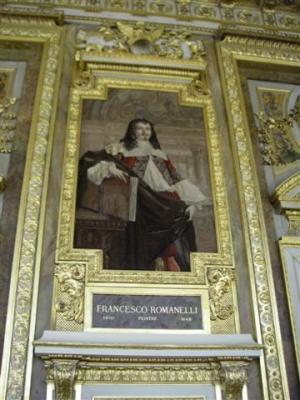
This room was full of fancy things. The centerpiece are Continue reading
Notre Dame Cathedral and the Louvre Museum
Our first stop this morning was at the Notre Dame Cathedral. The site was once a Gallo-Roman temple, which was replaced by a church, which was replaced by the cathedral. Construction began in 1163 and it was mostly completed by the mid-1300’s. It is 130 meters long, 48 meters wide, 35 meters tall and can hold 6,000 worshippers. The architectural style is French Gothic.
The French Revolutionists were very anti-church. During the revolution, the heads of all the statues of the kings in Notre Dame were cut off. Notre Dame became little used and fell into disrepair, and it was slated to be demolished. But then the book “The Hunchback of Notre Dame” came out and renewed interest in the cathedral, so it was spared destruction. The cathedral was restored in the 19th century, including heads being put on the mutilated statues. Interestingly enough, sometime later the heads were found buried in another part of town.
The cathedral is quite literally the “heart” of Paris. All distances from Paris to other parts of France are always measured from here, and this is “point zero” for all French roads. The cathedral has recently undergone a thorough exterior cleaning, using laser technology. The cleaning took several years. One spiral was left uncleaned so that people could compare what it looked like before and after. The spiral is black and the rest of the church is a light gray. The cathedral is the most visited site in France with 10 million people a year entering it.
We approached it and were a little disappointed to see it isn’t nearly as pretty as the Il Duormo in Milan. It is kind of blocky and stern, with the symmetrical duo of rectangular towers. The architect did attempt to soften the façade with some delicate Romanesque columns just under the towers. Above the doors is a horizontal line of statues set into the façade. We wonder if these are the beheaded kings.
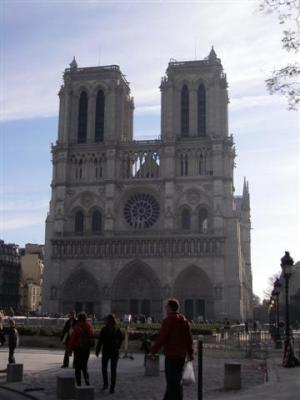
The first thing you notice when you walk in is that the ceilings are really high. The next thing you notice is the large and abundant stained glass windows. They really stand out against the unpainted walls, and it is clear that the stained glass really is the primary artwork. The stained glass, alcoves, balconies and doorways all have interesting shapes that give the interior a lot of structural character, but don’t overwhelm you like the baroque style does. The ceilings are vaulted and the support pillars are substantial in width. The chandeliers are large and eye catching. The floors are a simple black and white checker pattern. Eric was really taken by all the beautiful stained glass. This is one of his favorite churches yet.
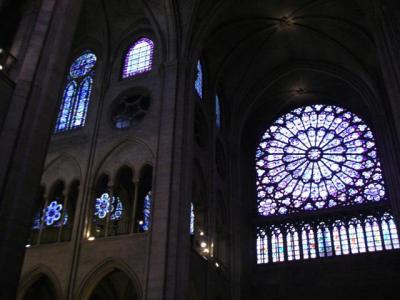
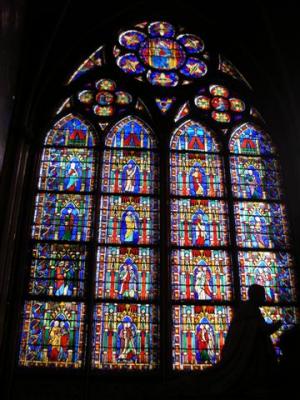
The entire exterior wall is lined with Continue reading
